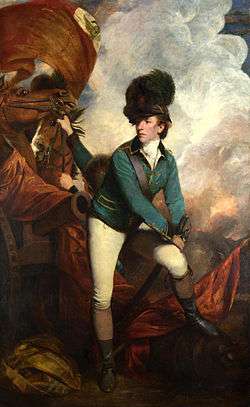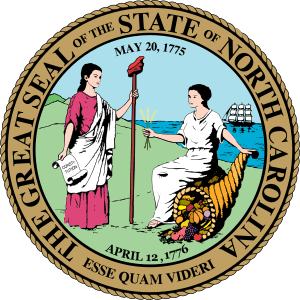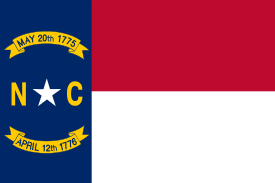Murfreesboro, North Carolina
Murfreesboro is a town in Hertford County, North Carolina, United States. The population was 2,835 at the 2010 census.[5] The town is home to Chowan University.
Murfreesboro, North Carolina | |
|---|---|
 | |
Location of Murfreesboro, North Carolina | |
| Coordinates: 36°26′28″N 77°5′49″W | |
| Country | United States |
| State | North Carolina |
| County | Hertford |
| Area | |
| • Total | 2.29 sq mi (5.93 km2) |
| • Land | 2.24 sq mi (5.80 km2) |
| • Water | 0.05 sq mi (0.13 km2) |
| Elevation | 85 ft (26 m) |
| Population (2010) | |
| • Total | 2,835 |
| • Estimate (2019)[2] | 2,961 |
| • Density | 1,322.47/sq mi (510.54/km2) |
| Time zone | UTC-5 (Eastern (EST)) |
| • Summer (DST) | UTC-4 (EDT) |
| ZIP code | 27855 |
| Area code(s) | 252 |
| FIPS code | 37-45640[3] |
| GNIS feature ID | 1021587[4] |
| Website | www |
Geography
Murfreesboro is located in northwestern Hertford County at 36°26′28″N 77°5′49″W (36.440983, -77.096901),[6] on high ground south of the Meherrin River. U.S. Route 258 runs through the east end of the town, and U.S. Route 158 bypasses the town to the south. US-258 leads southwest 51 miles (82 km) to Tarboro and northeast 21 miles (34 km) to Franklin, Virginia, while US-158 leads east 10 miles (16 km) to Winton, the Hertford county seat, and west 37 miles (60 km) to Roanoke Rapids.
According to the United States Census Bureau, the town has a total area of 2.3 square miles (5.9 km2), of which 2.2 square miles (5.8 km2) are land and 0.04 square miles (0.1 km2), or 2.27%, are water.[5]
Demographics
| Historical population | |||
|---|---|---|---|
| Census | Pop. | %± | |
| 1860 | 466 | — | |
| 1870 | 753 | 61.6% | |
| 1880 | 645 | −14.3% | |
| 1890 | 674 | 4.5% | |
| 1900 | 657 | −2.5% | |
| 1910 | 809 | 23.1% | |
| 1920 | 621 | −23.2% | |
| 1930 | 1,000 | 61.0% | |
| 1940 | 1,550 | 55.0% | |
| 1950 | 2,140 | 38.1% | |
| 1960 | 2,643 | 23.5% | |
| 1970 | 4,418 | 67.2% | |
| 1980 | 3,007 | −31.9% | |
| 1990 | 2,580 | −14.2% | |
| 2000 | 2,045 | −20.7% | |
| 2010 | 2,835 | 38.6% | |
| Est. 2019 | 2,961 | [2] | 4.4% |
| U.S. Decennial Census[7] | |||
As of the census[3] of 2000, there were 2,045 people, 919 households, and 574 families residing in the town. The population density was 946.7 people per square mile (365.5/km2). There were 986 housing units at an average density of 456.4 per square mile (176.2/km2). The racial makeup of the town was 60.00% White, 37.56% African American, 0.49% Native American, 0.24% Asian, 0.93% from other races, and 0.78% from two or more races. Hispanic or Latino of any race were 2.00% of the population.
There were 919 households, out of which 23.4% had children under the age of 18 living with them, 44.5% were married couples living together, 15.1% had a female householder with no husband present, and 37.5% were non-families. 34.1% of all households were made up of individuals, and 17.5% had someone living alone who was 65 years of age or older. The average household size was 2.22 and the average family size was 2.82.
In the town, the population was spread out, with 22.0% under the age of 18, 7.3% from 18 to 24, 23.2% from 25 to 44, 25.6% from 45 to 64, and 22.0% who were 65 years of age or older. The median age was 43 years. For every 100 females, there were 83.1 males. For every 100 females age 18 and over, there were 76.4 males.
The median income for a household in the town was $29,716, and the median income for a family was $43,417. Males had a median income of $31,392 versus $21,523 for females. The per capita income for the town was $17,054. About 11.5% of families and 18.6% of the population were below the poverty line, including 24.2% of those under age 18 and 14.7% of those age 65 or over.
History
Before European settlement
The first recorded inhabitants of the area were Native Americans from the Nottoway, Meherrin and Chowanoke tribes.[8]
The first European known to visit the area was John White of the Roanoke Colony in the 16th century. It was also visited by an expedition from Jamestown, Virginia, in the 17th century.[8]
The last native inhabitants, the Chowanoke, were expelled after warring with the English in 1675 and 1676. After that, they were moved to a reservation east of the Chowan River in what is now Gates County.[9]
Colonial era to the American Revolution
The first known deed to property in the area is a land grant dated November 5, 1714, made to Henry Wheeler for a tract on the Meherrin River which included what is now Murfreesboro. Several other transactions quickly followed, and in 1735 Joseph Parker founded the Meherrin Church. It is the second-oldest Baptist church in North Carolina[8] (now known as Meherrin Baptist Church).
On May 27, 1746, James Jordon Scott sold 150 acres (0.61 km2) on the Meherrin River (part of Wheeler's original grant) to an Irish immigrant, William Murfree from Nansemond County, Virginia. On December 12, 1754, the General Assembly designated Murfree's Landing as a King's Landing, where imports and exports would be inspected by a representative of the King.[8]
Revolution to the American Civil War

On July 17, 1781, British forces led by Banastre Tarleton and Tarleton's Raiders attacked Maney's Neck near Murfree's Landing. William Murfree's son, Hardy Murfree, led a local militia that repulsed the attack at Skinner's Bridge.[8]
William Murfree contributed 97 acres (390,000 m2) of land surrounding Murfree's Landing in 1787 to the growing settlement to form a town. The town was chartered by the General Assembly and renamed Murfreesboro on January 6, 1787.[8][10] This act also provided for the establishment of a public dock, as the town was located at the northernmost point of navigation on the Meherrin River.[8]
Murfreesboro was designated by the US Congress in 1790 as an official port of entry, and the customs records indicate a profitable three-cornered trade with New England and the West Indies.
In 1809, the Hertford Academy was established in Murfreesboro, opening in 1811 for male students. In 1814, Harriet Sketchly and Martha Sketchly arrived and expanded the female department of the academy considerably. By 1849, it was renamed as the Chowan Baptist Female Institute, the forerunner of Chowan University.[11]
In 1831 Murfreesboro was among towns that sent armed forces (these were led by Captain Solon Borland) to Southampton County, Virginia, to quell Nat Turner's slave rebellion.[12] As a result of these events, Virginia and North Carolina reduced the rights of free blacks, prohibiting education of both free blacks and slaves.
Education
Local children may attend Riverview Elementary School and Hertford County Middle School, both of which are part of the Hertford County Public Schools system.
Chowan University, a small Baptist university, is located in Murfreesboro.
Commerce
Murfreesboro is no longer an active port. The last commercial vessel to operate on a regular basis was a Texaco Oil barge; it ceased service to the town in October 1966.[8]
The town is served by the Roanoke-Chowan News-Herald newspaper, which is based in nearby Ahoskie.
Attractions
Numerous buildings of the town, mostly grand houses, are on the National Register of Historic Places: the David A. Barnes House, The Cedars, The Columns, Cowper-Thompson House, Freeman House, Melrose, Myrick House, Myrick-Yeates-Vaughan House, Francis Parker House, William Rea Store, Roberts-Vaughan House, and John Wheeler House. In addition, Princeton Site and the Murfreesboro Historic District are listed on the NRHP.[13][14]
The John Wheeler House is identified as the birthplace of John Hill Wheeler, a planter and politician who served as Minister to Nicaragua and North Carolina State Treasurer. In 2013 it was established that Hannah Bond, a slave who escaped to the North and wrote The Bondwoman's Narrative under the name of Hannah Crafts, had been held by him as a domestic servant. She escaped about 1857 from his plantation and wrote her manuscript on paper traced to his library. It was found in the early 21st century, authenticated and published for the first time in 2002 as the first known novel by an African-American woman.[15]
The old Murfreesboro public school (which housed grades 1 - 12 until 1972) has been redeveloped as the Brady C. Jefcoat Museum. It houses the collections of Brady Jefcoat, a Raleigh native. It includes hundreds of well-preserved ordinary items from the late 19th and early 20th century, including functional phonographs, radios, washing machines, and agricultural implements, as well as a wide variety of other novelties.[16]
Notable residents
- Hannah Crafts, first African-American woman and only fugitive slave woman to write a novel in the United States
- Tim Cofield, former NFL and CFL linebacker[17]
- Sallie Southall Cotten, writer and clubwoman[18]
- Curtis Deloatch, former cornerback in the NFL[19]
- Khalid Sheikh Mohammed, an Al Qaeda leader, attended Chowan University in 1983[20]
- Hardy Murfree, lieutenant colonel from North Carolina during the American Revolutionary War[21]
- Julian Myrick, insurance salesman and promoter of tennis[22]
- William N. H. Smith, Democratic congressman and North Carolina Supreme Court justice[23]
- Dwight Stephenson, center in the NFL, 5x First Team All-Pro selection and member of the Pro Football Hall of Fame[24]
- Fred Vinson, former NBA player and current coach[25]
- John H. Wheeler, first United States ambassador to Nicaragua and head of the United States Mint[8]
References
- "2019 U.S. Gazetteer Files". United States Census Bureau. Retrieved July 27, 2020.
- "Population and Housing Unit Estimates". United States Census Bureau. May 24, 2020. Retrieved May 27, 2020.
- "U.S. Census website". United States Census Bureau. Retrieved 2008-01-31.
- "US Board on Geographic Names". United States Geological Survey. 2007-10-25. Retrieved 2008-01-31.
- "Geographic Identifiers: 2010 Census Summary File 1 (G001): Murfreesboro town, North Carolina". American Factfinder. U.S. Census Bureau. Archived from the original on February 13, 2020. Retrieved December 20, 2017.
- "US Gazetteer files: 2010, 2000, and 1990". United States Census Bureau. 2011-02-12. Retrieved 2011-04-23.
- "Census of Population and Housing". Census.gov. Retrieved June 4, 2015.
- Stephenson, Frank E. Jr. (December 1986). Murfreesboro, North Carolina: 200 Years on the Meherrin River. Murfreesboro, North Carolina: Town of Murfreesboro. pp. 5–9.
- Parramore, Thomas C. (1969). The Ancient Maritime Village of Murfreesborough: 1787-1825. Murfreesboro, North Carolina: Johnson Publishing Company. p. 11. ISBN 0-930230-02-7.
- Parramore, Thomas C. (2001). Murfreesboro, North Carolina and the Founding of the American Republic 1608-1871. Murfreesboro, North Carolina: Murfreesboro Historicall Association, Inc. p. 1.
- Dr. Thomas C., Parramore (1969). The Ancient Maritime Village of Murfreesborough: 1787-1825. Murfreesboro, North Carolina: Johnson Publishing Company. pp. 52, 69. ISBN 0-930230-02-7.
- Parramore, Dr. Thomas C. (1998). Trial Separation: Murfreesboro, North Carolina and the Civil War. Murfreesboro, North Carolina: Murfreesboro Historical Association, Inc. p. 10. LCCN 00503566.
- "National Register Information System". National Register of Historic Places. National Park Service. July 9, 2010.
- "National Register of Historic Places Listings". Weekly List of Actions Taken on Properties: 6/09/14 through 6/13/14. National Park Service. 2014-06-20.
- Bosman, Julie (18 September 2013). "Professor Says He Has Solved a Mystery Over a Slave's Novel". The New York Times. Retrieved 19 September 2013.
- "The Brady C. Jefcoat Museum". Murfreesboro Historical Association. 2007. Archived from the original on 2008-01-31. Retrieved 2007-12-27.
- Tim Cofield Stats. Pro-Football-Reference. Retrieved 24 June 2019.
- Sallie Southall Cotten. docsouth.unc.edu. Retrieved 24 June 2019.
- "Curtis Deloatch". Carolina Panthers. NFL Enterprises LLC. 2007. Retrieved 2007-12-27.
- Eggen, Dan (July 27, 2004). "9/11 Report Says Plotter Saw Self as Superterrorist". Washington Post. pp. A1.
- Col. Hardy Murfree. Tennessee Portrait Project. Retrieved 24 June 2019.
- Julian Myrick - International Tennis Hall of Fame. International Tennis Hall of Fame. Retrieved 24 June 2019.
- "SMITH, William Nathan Harrell, (1812 - 1889)". Biographical Directory of the United States Congress. United States Congress. Retrieved 14 May 2018.
- Dwight Stephenson - The Pro Football Archives. The Pro Football Archives. Retrieved 24 June 2019.
- Fred Vinson. Chowan University. Retrieved 24 June 2019.

